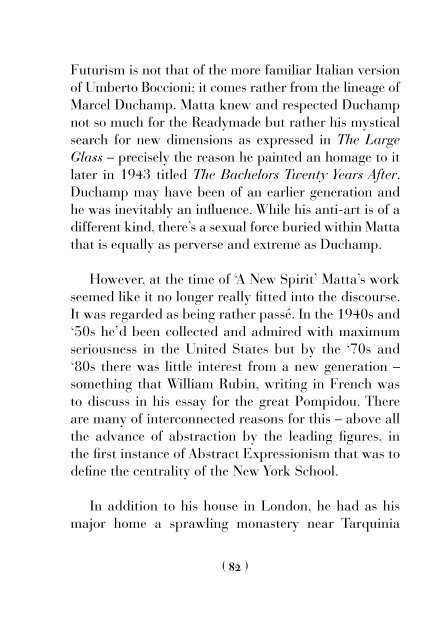Matta-Duchamp
Illustrated catalog featuring full page color illustrations and rare documentary photographs. Published by Galerie Gmurzynska in June 2018 to accompany a special cabinet exhibition at Art Basel 2018. The book includes texts by Professor Dawn Adès and Norman Rosenthal. It coincides with a broader re-evaluation of the importance of Matta internationally as well as of the influence of Duchamp on the work of 20th century artists. Edited and introduced by Krystyna Gmurzynska and Mathias Rastorfer. Essays by Dawn Adès and Norman Rosenthal. Historic interview excerpt by Robert Motherwell. 90 pages with 7 illustrations. Softcover. ISBN: 978-3-905792-09-6
Illustrated catalog featuring full page color illustrations and rare documentary photographs.
Published by Galerie Gmurzynska in June 2018 to accompany a special cabinet exhibition at Art Basel 2018. The book includes texts by Professor Dawn Adès and Norman Rosenthal. It coincides with a broader re-evaluation of the importance of Matta internationally as well as of the influence of Duchamp on the work of 20th century artists.
Edited and introduced by Krystyna Gmurzynska and Mathias Rastorfer.
Essays by Dawn Adès and Norman Rosenthal.
Historic interview excerpt by Robert Motherwell.
90 pages with 7 illustrations.
Softcover.
ISBN:
978-3-905792-09-6
You also want an ePaper? Increase the reach of your titles
YUMPU automatically turns print PDFs into web optimized ePapers that Google loves.
Futurism is not that of the more familiar Italian version<br />
of Umberto Boccioni; it comes rather from the lineage of<br />
Marcel <strong>Duchamp</strong>. <strong>Matta</strong> knew and respected <strong>Duchamp</strong><br />
not so much for the Readymade but rather his mystical<br />
search for new dimensions as expressed in The Large<br />
Glass – precisely the reason he painted an homage to it<br />
later in 1943 titled The Bachelors Twenty Years After.<br />
<strong>Duchamp</strong> may have been of an earlier generation and<br />
he was inevitably an influence. While his anti-art is of a<br />
different kind, there’s a sexual force buried within <strong>Matta</strong><br />
that is equally as perverse and extreme as <strong>Duchamp</strong>.<br />
However, at the time of ‘A New Spirit’ <strong>Matta</strong>’s work<br />
seemed like it no longer really fitted into the discourse.<br />
It was regarded as being rather passé. In the 1940s and<br />
‘50s he’d been collected and admired with maximum<br />
seriousness in the United States but by the ‘70s and<br />
‘80s there was little interest from a new generation –<br />
something that William Rubin, writing in French was<br />
to discuss in his essay for the great Pompidou. There<br />
are many of interconnected reasons for this – above all<br />
the advance of abstraction by the leading figures, in<br />
the first instance of Abstract Expressionism that was to<br />
define the centrality of the New York School.<br />
In addition to his house in London, he had as his<br />
major home a sprawling monastery near Tarquinia<br />
( 82 )

















